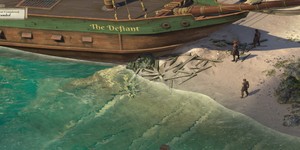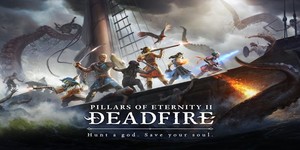Obsidian have improved and updated the formula Baldur's Gate established in a variety of ways. This isn't entirely subtle either. It's visible on the surface. The gorgeous hand-painted backdrops are blended with modern graphical techniques. Gloomy dungeons and tavern taprooms flicker with dynamic candlelight, while the lush greenery of the game's rural areas are cut through with flowing rivers and glittering pools. All the character models are 3D too, lending them just a little extra presence as they traverse the landscape.
At a deeper level, the RPG rules and lore are entirely of Obsidian's own devising, as opposed to Baldur's Gate's basis on the Forgotten Realms ruleset. We'll discuss combat shortly. For now let's focus on the world of Pillars. Like the general outline, it's ostensibly traditional, but more original than it initially seems. There are dragons and skeletons and wizards and skeleton wizards and elves and rogues and gods and dukes, some of which have unique names (elves are "Glanfathans") while others don't (Dragons are dragons). There's a secret cult doing secret things which you must secretly investigate. There's a conflict between the civilising advances of magic and the defiling of the natural order. There's even a haunted lighthouse.
Yet while the ingredients are familiar, Obsidian's recipe results in an often surprising dish. I'll avoid going into too much detail, but Pillars reverses a recent trend in RPGs where the main quest exists merely a structure to pull you into the more interesting side attractions. By comparison, Pillars' central storyline is almost always its most gripping part. It deals with the reincarnation of souls, the complicity of a person in their previous lives, and what happens after you kill a God.
Understanding the story does involve digesting quite a lot of lore. But I was impressed by how Pillars puts so much of its back-story to purpose, and usually frames its most interesting bits front and centre. That said, it falters in the third act, burying a fairly brief quest-line in an encyclopaedia of elvish nonsense. But it's worth persevering to the fourth and final act, where all the game's mysteries are revealed to you in a single, devastating line.
Although the main quest is the most intriguing, Obsidian's best writing is dedicated to your party characters and the interactions between them. They're all worth spending time with, but if I had to pick a favourite, it would be between Edér and Kana. Edér is a gentle-voiced ex-soldier with a sardonic wit and an adorable fondness for animals. Kana, meanwhile, is an endlessly cheerful Aumaua Chanter who has a taste for adventure and a love of storytelling. Oh, and Durance is fantastic too, but I'll let you discover his special brand of madness for yourself.
Excellent though the companion dialogue may be, their personal quests are a little underwhelming. At the very least, their set-ups are much better than their payoffs. While this fits with some of the game's themes, there's a difference between not finding precisely what you're looking for, and your mission fizzling out entirely. The broader activities range from helping a farmer find his missing pigs to exploring an absolutely massive dungeon fittingly named the Endless Paths. Most quests offer multiple solutions that cater towards different roles, Raedric's castle forming a good early example of the variety on show.
That said, nearly all quests involve fighting at some point. Combat in Pillars of Eternity carefully treads the line between depth and accessibility. Victory relies heavily on discerning the strengths of the various characters (including your own) and then committing to those roles. Fighters, for example, require either a high deflection rating in order to absorb enemy attacks, or a high damage output to carve through your opponent's ranks. Priests like
Durance offer a wide range of healing, buffing, and weakening spells. Druids are all about environmental damage output, while Rangers can use their pet to keep an enemy at bay while they deal damage from afar. Arguably the most interesting class is the Chanter, who sings as the battle unfolds, and each chanted phrase gives him access increasingly powerful abilities. Character class makes a huge difference to how you approach Pillars of Eternity, and it's great to develop your own tactical approach as the game goes on.
At a deeper level, the RPG rules and lore are entirely of Obsidian's own devising, as opposed to Baldur's Gate's basis on the Forgotten Realms ruleset. We'll discuss combat shortly. For now let's focus on the world of Pillars. Like the general outline, it's ostensibly traditional, but more original than it initially seems. There are dragons and skeletons and wizards and skeleton wizards and elves and rogues and gods and dukes, some of which have unique names (elves are "Glanfathans") while others don't (Dragons are dragons). There's a secret cult doing secret things which you must secretly investigate. There's a conflict between the civilising advances of magic and the defiling of the natural order. There's even a haunted lighthouse.
Yet while the ingredients are familiar, Obsidian's recipe results in an often surprising dish. I'll avoid going into too much detail, but Pillars reverses a recent trend in RPGs where the main quest exists merely a structure to pull you into the more interesting side attractions. By comparison, Pillars' central storyline is almost always its most gripping part. It deals with the reincarnation of souls, the complicity of a person in their previous lives, and what happens after you kill a God.
Understanding the story does involve digesting quite a lot of lore. But I was impressed by how Pillars puts so much of its back-story to purpose, and usually frames its most interesting bits front and centre. That said, it falters in the third act, burying a fairly brief quest-line in an encyclopaedia of elvish nonsense. But it's worth persevering to the fourth and final act, where all the game's mysteries are revealed to you in a single, devastating line.
Although the main quest is the most intriguing, Obsidian's best writing is dedicated to your party characters and the interactions between them. They're all worth spending time with, but if I had to pick a favourite, it would be between Edér and Kana. Edér is a gentle-voiced ex-soldier with a sardonic wit and an adorable fondness for animals. Kana, meanwhile, is an endlessly cheerful Aumaua Chanter who has a taste for adventure and a love of storytelling. Oh, and Durance is fantastic too, but I'll let you discover his special brand of madness for yourself.
Excellent though the companion dialogue may be, their personal quests are a little underwhelming. At the very least, their set-ups are much better than their payoffs. While this fits with some of the game's themes, there's a difference between not finding precisely what you're looking for, and your mission fizzling out entirely. The broader activities range from helping a farmer find his missing pigs to exploring an absolutely massive dungeon fittingly named the Endless Paths. Most quests offer multiple solutions that cater towards different roles, Raedric's castle forming a good early example of the variety on show.
That said, nearly all quests involve fighting at some point. Combat in Pillars of Eternity carefully treads the line between depth and accessibility. Victory relies heavily on discerning the strengths of the various characters (including your own) and then committing to those roles. Fighters, for example, require either a high deflection rating in order to absorb enemy attacks, or a high damage output to carve through your opponent's ranks. Priests like
Durance offer a wide range of healing, buffing, and weakening spells. Druids are all about environmental damage output, while Rangers can use their pet to keep an enemy at bay while they deal damage from afar. Arguably the most interesting class is the Chanter, who sings as the battle unfolds, and each chanted phrase gives him access increasingly powerful abilities. Character class makes a huge difference to how you approach Pillars of Eternity, and it's great to develop your own tactical approach as the game goes on.

MSI MPG Velox 100R Chassis Review
October 14 2021 | 15:04


![Pillars of Eternity Review [FRIDAY] Pillars of Eternity Review](http://images.bit-tech.net/content_images/2015/04/pillars-of-eternity-review/pillars4-614x345.jpg)
![Pillars of Eternity Review [FRIDAY] Pillars of Eternity Review](http://images.bit-tech.net/content_images/2015/04/pillars-of-eternity-review/pillars5-614x345.jpg)
![Pillars of Eternity Review [FRIDAY] Pillars of Eternity Review](http://images.bit-tech.net/content_images/2015/04/pillars-of-eternity-review/pillars7-614x345.jpg)
![Pillars of Eternity Review [FRIDAY] Pillars of Eternity Review](http://images.bit-tech.net/content_images/2015/04/pillars-of-eternity-review/pillars8-614x345.jpg)








Want to comment? Please log in.